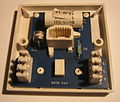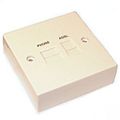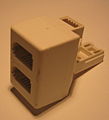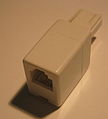Talk:British telephone socket
| This article is rated Start-class on Wikipedia's content assessment scale. It is of interest to the following WikiProjects: | |||||||||||
| |||||||||||
| This article is based on material taken from the Free On-line Dictionary of Computing prior to 1 November 2008 and incorporated under the "relicensing" terms of the GFDL, version 1.3 or later. |
Section on the bell wire anachronism[edit]
The bell wire on pin 3 seems a very UK-specific curiosity and it would be nice if we had a section that explained the historic motivation behind it clearly (something to do with cross-talk problems from pulse dialling, I've been told). It sounds much like an anachronism today: the original motivation for it (pulse dialling) no longer exists, and it now causes serious cross-talk and EMC problems by being an unbalanced interface, and therefore incompatible with twisted-pair lines, especially for ADSL users. I wonder when the UK follows New Zealand and simply drops what has been a pretty bad idea to start with. Modern phones shouldn't require it; they surely all use chips that also work in countries without bell wires. Markus Kuhn (talk) 21:55, 9 April 2012 (UTC)
- You are in some ways correct. Currently available telephones do not use the separate ringer connection as they are able to sense the ringer current from the remaining two wires (just as modems have done more or less since they appeared). This also makes the telephones marketable to other telephone systems that do not use a separate ringer wire (e.g. Republic of Ireland, I believe). The ringer wire is generally connected to provide compatibility with older telephones that require it. 109.145.22.224 (talk) 12:53, 26 April 2012 (UTC)
- Bell tinkle wasn't just a problem when dialling, but also when other instruments on the same pair were taken off hook (picking up another extension). A comparison with US practice would be welcome. Andy Dingley (talk) 13:02, 26 April 2012 (UTC)
- I believe that the capacitor in the master socket also forms part of the anti-side tone circuit in older telephones in addition to serving the bell.174.25.60.231 (talk) 08:59, 30 November 2014 (UTC) 174.25.60.231 (talk) 08:56, 30 November 2014 (UTC)
- Some of us have upgraded antique telephones and a small PBX at home. The ring capacitor is very necessary for a 1950s 312, and even the 20 year old DTMF push button "Converse 320". I still sometimes come across a 746, old modems and fax machines that use pulse dial too. The PSTN still supports it in most areas. — Preceding unsigned comment added by Birdwes (talk • contribs) 20:28, 17 September 2018 (UTC)
- It's actually not UK specific. France used a similar arrangement with a capacitor in the socket as did the Republic of Ireland. However, in both cases they did not continue to use it with modern instruments which have an "anti tinkle circuit". However, the capacitors still exist in French "T" sockets and Irish modular RJ11 sockets. 3 wire extensions however weren't normally used but were possible. — Preceding unsigned comment added by 95.44.81.120 (talk) 15:12, 10 November 2018 (UTC)
Broadband[edit]
To improve ADSL performance and reliability it is often recommended that the ringer wire is disconnected in any unfiltered parts of the system. More information on this would be usefule as I have never heard about this Deben Dave 08:37, 5 October 2007 (UTC)
- Well there is no need for it in the unfiltered part of the system and having an extra wire hanging off your line through a capacitor (which essentially looks like a short at high frequencies) is not going to be positive for the lines high frequency behavior. I've seen it reccomended as the first thing to try for ADSL problems from quite a few people who do phone installation work professionally but unfortunately I can't find a good cite. Plugwash 08:44, 5 October 2007 (UTC)
- Basically the A and B wires are balanced, and the effect of the bell wire by dint of connection unbalances the line through the combination of the capacitor and resistor in the master socket. The connection to both wires is unequal, so contributes to potential interference from local interference and strong radio signals in the MF band (300kHz - 3MHz). Metazeitgeist (talk) 21:59, 14 June 2022 (UTC)
Did it not go a bit like this?[edit]
"...introduced a plug and socket system to allow subscribers to connect telephones on the 19th November 1981. This replaced the older hard-wired system"
There was already an older plug and socket system- a single pin design the name of which I know not, but we had it in our house. So we did. The plug was stripey. —Preceding unsigned comment added by 78.12.69.244 (talk) 14:12, 23 November 2007 (UTC)
- That was the Post Office Plan 4 System - might merit a small mention, perhaps?? Also, the fact that the BT/BS6312 plug was chosen by Telecom New Zealand for use over there. (RM21 (talk) 05:50, 5 January 2008 (UTC))
StandardsDirect.org[edit]
I removed the link to a standards purchase site, standardsdirect.org. See Wikipedia talk:WikiProject Spam#StandardsDirect.org for more about this site. As I see it, Wikipedia is not a directory and we're not here to help people sell things. Most of these standardsdirect.org links have been added by single purpose accounts who likely have a conflict of interest. See:
If an established, high-volume editor wants to add it back to the article, by all means go ahead. Otherwise, it stays out pending resolution at the spam discussion link above. --A. B. (talk • contribs) 00:50, 23 October 2008 (UTC)
Reversed latch[edit]
"The 430A and 630A plugs had the latch on the opposite side of the plug, and were used as headset plugs on some switchboards and as handset connectors on some telephones, eg Ambassador."
I have worked somewhere where there was wall sockets with the latch on the opposite side to normal, I believe they were from a legacy system and not in use, so I don't know what they were intended for, but presumably not one of the mentioned uses.
Also, I seem to remember there were variants to the "standard" plug that were "keyed" in a way that they weren't compatible, by having (if I remember correctly) the latch not taking up the whole "height" of the plug. Anyone else remember this?
Yeryry (talk) 21:03, 15 August 2011 (UTC)
- Could they have been for computer networking? Particularly if it was Newbury equipment, or if you were working in a UK government offce (particularly the DHSS). Andy Dingley (talk) 22:37, 15 August 2011 (UTC)
- 630A plugs (latch on opposite side) with corresponding jacks were used on some BT PBX equipment, in order to avoid the specific key telephones being connected to a "normal" telephone jack, and vice versa. 146.90.147.230 (talk) 17:01, 14 July 2013 (UTC)
Picture near the end - citing US instruments[edit]
The BT line plug at the back looks very much as if the other (or office) side is RJ45. There would be very few reasons to import US telephone eqpt here and anyhow they would be RJ11. The US system provided a 24v dc local loop and so our 48-50v would be over-driving it.
I think the adapter shown would be more use in connecting a PSTN NTE into an RJ45 Cat V for patch for passage into a building or premises wiring scheme. — Preceding unsigned comment added by 81.154.189.208 (talk) 14:46, 16 September 2011 (UTC)
- First, the widespread use of RJ-45 to refer to the 8P8C jacks and plugs used on data networks is incorrect (I've just amended some references in the structured cabling section accordingly). Second, all modern U.S. telephone systems use 48V battery, not 24V, and have done for a very long time. It's only some old systems, now long gone, which used 24V (the U.K. also had other battery voltages in the past, most notably 22V and 40V, but they are also long gone with 50V now standard).
146.90.147.230 (talk) 16:56, 14 July 2013 (UTC)
Possible copyright violation[edit]
The file File:Phone Socket the principle of operation.jpg has an uncertain copyright status and may be deleted. You can comment on its removal. –LiveRail < Talk > 15:25, 10 December 2014 (UTC)
Inaccuracies in the "Plugs" section[edit]
I made a change a few months ago which has since been reverted (by accident following some vandalism?) relating to the connectors with "W style" polarisation used on Sinclair machines. I don't want to be accused of edit warring so I haven't just changed it back immediately. I don't have any particularly good citations for these things besides the codes being moulded into the plugs, but I note that the incorrect information about Sinclair's use of the "W" connectors has no citations either.
I've since noticed another error in that section, which states "the pins on the BT431A plug are numbered in the opposite direction to those on the corresponding BT431A socket." There is no such thing as a BT431A socket. BT431A is the code for a right handed 4 pin plug, it mates with any of the right handed 6 way sockets with "A" type polarisation in the connector family. 87.243.208.102 (talk) 00:01, 20 July 2015 (UTC)
- Ok I've gone ahead and made several changes in that section to correct errors and also hopefully add clarity to certain statements 87.243.208.102 (talk) 17:32, 10 November 2015 (UTC)
Removal of gallery[edit]
Someone at WP:OTRS wrote in questioning the 18 January removal of this gallery.
-
LJ 2/1A - BT Master socket showing components - surface mounted
-
LJ 2/3A - BT Secondary socket - surface mounted
-
LJ 1/1A - Compact Master socket for use where space is at a premium - surface mounted
-
LJ 4/1A - Two Exchange Line Master socket - flush fitting. Standard BS fitting
-
LJ 3/3A - Secondary - flush fitting. Standard BS fitting
-
LJ 5/1A - Double Master - flush fitting- note straps paralleling the second socket into a master as well. Standard BS fitting
-
LJ 5/3A - Double secondary - flush fitting. Standard BS fitting
-
LJ 2/1A - BT Master socket converted to a secondary by removing components
-
Master with ADSL Filter - surface mounted
-
Adapter to provide two sockets off a single socket, and a connection for an external socket
-
Adapter to provide three sockets off a single socket
-
Adapter to provide four sockets off a single socket
-
ADSL Filter Plug
-
Adapter to allow an North American-type telephone plugs to be used
Thoughts from anyone? Blue Rasberry (talk) 15:57, 29 January 2016 (UTC)
- A new Wikipedian, GreenOctopus, restored the gallery. Thanks for coming to Wikipedia and sharing your thoughts on what is best here. Blue Rasberry (talk) 02:19, 1 February 2016 (UTC)
Thanks Blue Rasberry.
- I restored it as the gallery is linked to several times a year on at least one broadband help site as a reference document, for people with broadband problems possibly related to home phone wiring. It lets them identify to the helpers what old sockets they have so some types of sub-optimal installation can be diagnosed. I did leave out the random multi-socket connectors as they served no purpose in my opinion. GreenOctopus (talk) 22:06, 2 February 2016 (UTC)
- It's well over the top and doesn't belong here. If you really want a gallery of all the New Plan sockets, then create a gallery page at Commons. Andy Dingley (talk) 22:45, 2 February 2016 (UTC)
External links modified[edit]
Hello fellow Wikipedians,
I have just added archive links to one external link on British telephone sockets. Please take a moment to review my edit. You may add {{cbignore}} after the link to keep me from modifying it, if I keep adding bad data, but formatting bugs should be reported instead. Alternatively, you can add {{nobots|deny=InternetArchiveBot}} to keep me off the page altogether, but should be used as a last resort. I made the following changes:
- Attempted to fix sourcing for http://www.tcf.org.nz/library/e72d1374-8040-4022-ba79-428d56eb4a9b.cmr
When you have finished reviewing my changes, please set the checked parameter below to true or failed to let others know (documentation at {{Sourcecheck}}).
This message was posted before February 2018. After February 2018, "External links modified" talk page sections are no longer generated or monitored by InternetArchiveBot. No special action is required regarding these talk page notices, other than regular verification using the archive tool instructions below. Editors have permission to delete these "External links modified" talk page sections if they want to de-clutter talk pages, but see the RfC before doing mass systematic removals. This message is updated dynamically through the template {{source check}} (last update: 18 January 2022).
- If you have discovered URLs which were erroneously considered dead by the bot, you can report them with this tool.
- If you found an error with any archives or the URLs themselves, you can fix them with this tool.
Cheers.—cyberbot IITalk to my owner:Online 14:19, 30 March 2016 (UTC)
Making the connections[edit]
Hello everyone
I believe this section should be edited to remove some of the pictures, namely the pictures of cable and sockets, as this doesn't really directly relate to the content of the paragraph, focused as it is on the use of IDC. More relevant would be a picture of the pushdown tool in the process of inserting a cable into the IDC connectors on the back of the socket. Also, I think that the title is a little too fancy; perhaps a better title would be "Use of IDC connectors".
Hello to all the other telephone engineers, Cheers, Steve. Landlineman (talk) 20:00, 18 August 2016 (UTC)
- There are lots of pictures - maybe not all are needed, although the variations do need illustration.
- As to renaming as "Use of IDC connectors", I think that would be a terrible change. The article is about UK phones becoming pluggable, as part of the process along with green circle sticker licensing and the novel ability to buy a phone instrument (and no longer rent one) which was a key part of the liberalisation of UK domestic phone service around 1980, at the end of the PO era. IDC is very secondary to this. These connectors were used for a long time with some use of IDC, but the MDF was still soldered and there were even some sockets (for use with legacy premises wiring) which had screw terminals. Andy Dingley (talk) 20:29, 18 August 2016 (UTC)
Andy the specific section [Making the connections] I'm referring to absolutely only discusses IDC connections, yet shows pictures of sockets, 2pr and 3pr cables. It's this section I'm proposing needs improvement, not the whole article.
Landlineman (talk) 07:12, 19 August 2016 (UTC)
- Sorry, my mistake.
- I think there needs to be only a few images there: a Krone, a plastic tool, some cable (with colours fixed in the image) showing the new colours as intermittent bands rather than solid, and also just one socket plate with cable on. Andy Dingley (talk) 10:32, 19 August 2016 (UTC)
Hi Andy, I agree. Also, do you think it would be of benefit to have a picture showing the push down tool inserted into an IDC - if so I can photograph it. Secondly, I think it can and I wondered if you do too, whether the cabling section could be improved? It seems a little too weighted on the historical side of wiring rather than things as they are now, not to remove what is said in that section, but do you think additional information such as internal cable and drop wire types used currently, pair colours etc would be of benefit, or is that straying a bit too much beyond "British Telephone Sockets". I have to admit I'm undecided either way, but I'm inclined towards inclusion as I know these telco articles often seem to be referenced on tech help forums, so it may be useful.
Landlineman (talk) 16:34, 19 August 2016 (UTC)
- I think "sockets" can include internal premises wiring, but not drop cables. A punch-down image might be useful - or is it clear enough just showing wires in place? The image at punch down tool isn't great.
- Many of us still have old wiring too! I have fibre to the cabinet opposite, but from my dropwire to the master socket is still 1950s (can I get anyone to renew it? Can I hell!) Andy Dingley (talk) 17:01, 19 August 2016 (UTC)
External links modified[edit]
Hello fellow Wikipedians,
I have just modified 3 external links on British telephone socket. Please take a moment to review my edit. If you have any questions, or need the bot to ignore the links, or the page altogether, please visit this simple FaQ for additional information. I made the following changes:
- Added archive https://web.archive.org/web/20130617003810/http://www.sinet.bt.com:80/351v4p5.pdf to http://www.sinet.bt.com/351v4p5.pdf
- Added archive https://web.archive.org/web/20160422152929/http://evonet.com/evonet/index.asp?Page=102 to http://www.evonet.com/evonet/index.asp?Page=102
- Added archive https://web.archive.org/web/20120426001315/http://www.evonet.com/evonet/index.asp?Page=43 to http://www.evonet.com/evonet/index.asp?Page=43
When you have finished reviewing my changes, please set the checked parameter below to true or failed to let others know (documentation at {{Sourcecheck}}).
This message was posted before February 2018. After February 2018, "External links modified" talk page sections are no longer generated or monitored by InternetArchiveBot. No special action is required regarding these talk page notices, other than regular verification using the archive tool instructions below. Editors have permission to delete these "External links modified" talk page sections if they want to de-clutter talk pages, but see the RfC before doing mass systematic removals. This message is updated dynamically through the template {{source check}} (last update: 18 January 2022).
- If you have discovered URLs which were erroneously considered dead by the bot, you can report them with this tool.
- If you found an error with any archives or the URLs themselves, you can fix them with this tool.
Cheers.—InternetArchiveBot (Report bug) 00:40, 9 November 2016 (UTC)
fibre-to-the-consumer[edit]
One of the pictures is captioned BT fibre-to-the-consumer (FTTC) vDSL faceplate - I always thought FTTC stood for fibre to the cabinet, the cabinet being a local distribution cabinet for multiple consumers and therefore not entirely proximate to the consumer, with FTTP being fibre to the premises which is much more accurately proximate to the consumer. — Preceding unsigned comment added by 78.32.68.244 (talk) 17:44, 3 July 2017 (UTC)














